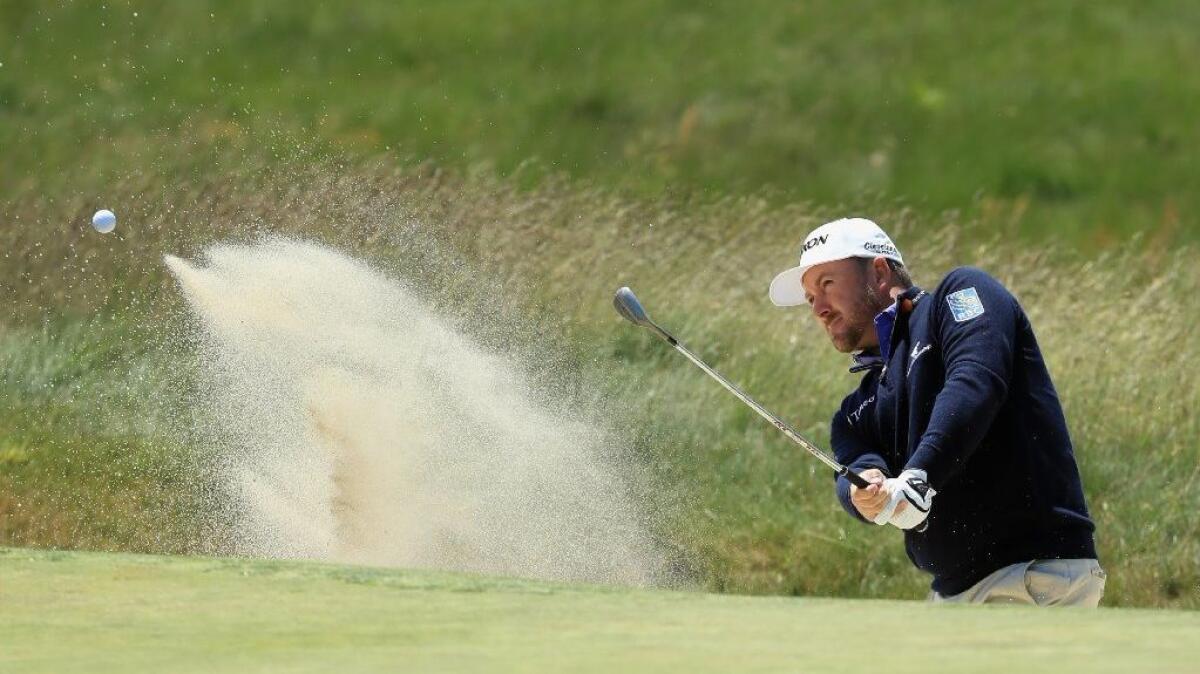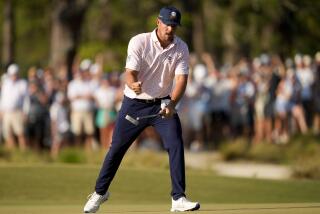Shinnecock Hills Golf Club course seems ready to shape another U.S. Open champion
- Share via
Reporting from southampton, n.y. — History holds a regular tee time at Shinnecock Hills Golf Club. Founded in 1891, it is the oldest incorporated golf club in the country.
Inside a white tent just off the first fairway, Mike Davis, chief executive of the USGA, considers the past ahead of the 118th U.S. Open to be held this week.
He calls the course “a national treasure,” throws laurels at the aesthetics and notes the extended length — 7,445 yards to be played to a par of 35-35 — 70. He tracks the landscape’s evolution, referencing aerial views, fairway contours and shot values.
Not all history is hallowed, though. Davis broaches the hell that still haunts the clubhouse. It was 14 years ago, during the final day of the 2004 U.S. Open, when the greens ran dry on No. 7.
“We’re happy that we have a mulligan this time,” Davis said. “Certainly it was a bogey last time. Maybe a double bogey.”
The green turned to rock that Sunday morning. The first four players took three triple bogeys and a bogey at the hole. Walter Driver, chairman of the USGAs Championship Committee, ordered the grounds crew to water the greens then. By day’s end, three players made birdie.
On the score sheets, there were 28 pars, 27 bogeys, five double bogeys and the three triple bogeys. Retief Goosen and Phil Mickelson managed par that Sunday as Goosen claimed his second Open trophy, this time by two strokes with a four-under-par 276.

“I think that everybody who was either here or watched it, realized that we had a situation that on some holes, and particularly the seventh hole itself, you were watching well-executed shots not being rewarded,” Davis said. “In fact, in the case of seven, you saw some well-executed shots actually get penalized. And I can assure you that was not what the USGA wanted.”
There will be 156 golfers back on the course for the return of the U.S. Open. The seventh hole measures at 189 yards this time, as it did in 2004. It is a par three. Branded as golf’s ultimate test, Davis maintains that the Open’s advancements have eliminated the possibility of the same nightmare emerging. He insists there will be better communication between the groundskeepers and the USGA.
“I would just say it was 14 years ago, it is a different time, it was different people,” Davis said. “We, as an organization, we learned from it. When you set up a US Open, it is golf’s ultimate test. It is probably set up closer to the edge than any other event in golf. I think the difference, then versus now, we have a lot more technology, a lot more data on hand.
“Frankly, what really happened was just a lack of water. There just wasn’t enough water put in. The grass itself went dormant. There wasn’t enough friction on the greens. Nowadays, you have everything from firmness meters. We’ve got moisture meters in the greens, things that tell us how fast the greens are running. Meteorology is better. We not only know where the winds are coming from and the velocities. We’re comfortable.”
The forecast was for mostly dry conditions with perhaps not as much wind as this part of Long Island typically gets in June. A big difference 14 years later is the closely mown areas around the greens, which will cause golf balls to roll 15 yards or more away. The length of the course appears to be a secondary concern.
“It’s back to being a pure U.S. Open with serious discipline in your iron play,” said Graeme McDowell, the 2010 Open champion at Pebble Beach. “I don’t look at it and say, ‘I’m not long enough to win here.’ And that excites me. I haven’t seen anything that has upset me.”
This will be the fourth U.S. Open of the modern era to be played at Shinnecock, the lone course to have hosted the U.S. Open in three different centuries. Raymond Floyd won in 1986 and Corey Pavin took the Centennial U.S. Open title in 1995, sealing his victory with a four-wood to the 18th green.
The USGA already has awarded the 2026 U.S. Open to Shinnecock, and the U.S. Open will be back in the tri-state area in 2020 at Winged Foot’s West Course in Mamaroneck. Only 19 players from the 2004 U.S. Open are back for this year’s edition, including Adam Scott.
“It’s considerably wider and more generous off the tee than it was in ’04,” Scott said. “It’s very fair off the tee. And it’s very penal if you miss.”
After walking the back nine Saturday evening and playing the front nine Sunday afternoon, McDowell was convinced of one thing.
“I think we’re back to a U.S. Open mentality,” he said.
How the first four U.S. Opens at Shinnecock Hills Golf Club in Southampton, N.Y., unfolded:
1896
Winner: James Foulis.
Margin of victory: Three strokes.
Runner-up: Horace Rawlins.
What happened: Shinnecock hosted the second-ever U.S. Open, a 36-hole tournament with only 35 competitors. James Foulis of Scotland edged out the previous year’s champion Horace Rawlins by three strokes to earn the $150 prize (roughly $4,200 in 2018) and his only major victory. Foulis later invented what became the seven-iron along with his brother David.
1986
Winner: Raymond Floyd.
Margin of victory: Two strokes.
Runner-ups: Chip Beck and Lanny Wadkins.
What happened: Greg Norman began Sunday of the 1986 Open with the lead, but the Australian blew up with a five-over 75 in the final round and finished 12th. Raymond Floyd birdied three times on the back nine to distance himself from the pack and win by two strokes at one under. The title was Floyd’s first U.S. Open win and fourth major overall.
1995
Winner: Corey Pavin.
Margin of victory: Two strokes.
Runner-up: Greg Norman.
What happened: Norman started strong again at Shinnecock, finishing the second round with a two-shot lead at five under. “The Shark” fell apart over the weekend yet again and ended the tournament in second at two over. On a brutal course that didn’t allow any finishers under par, Corey Pavin entered the final round three strokes behind Norman and Tom Lehman but managed a two-under 68 to secure a two-stroke victory. The win was Pavin’s only major title.
2004
Winner: Retief Goosen
Margin of victory: Two strokes
Runner-up: Phil Mickelson
What happened: Retief Goosen entered the blustery Sunday with a two-stroke lead but Phil Mickelson briefly overtook him on the back nine. However, Mickelson three-putted from five feet to double-bogey 17, while Goosen birdied the 16th to restore his two-stroke lead. Goosen won comfortably at four under for his second U.S. Open title with his first coming at Southern Hills in 2001. Meanwhile, Mickelson is still yet to win the U.S. Open, finishing second six times.
The Associated Press contributed to this story.
sports@latimes.com
More to Read
Go beyond the scoreboard
Get the latest on L.A.'s teams in the daily Sports Report newsletter.
You may occasionally receive promotional content from the Los Angeles Times.










